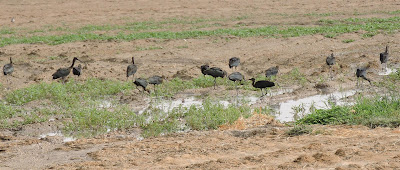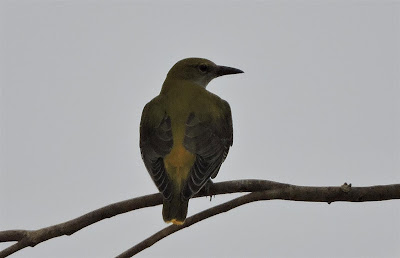It was a good start on arrival when in the gloom of dawn, the first birds I saw were 15 European turtle dove resting on a sand bank. It was too dark to get photographs and they moved off quickly. However I caught up with two again at the very end of the session.
The doves were the only birds not showing signs of the heat at that time of day.
The rosy starling and house sparrow near-by were all panting.
European turtle dove (centre)
Also very early a Montagu's harrier flew over a field. It rested for a few minutes on the ground too. Then it was mobbed by a couple of brown-necked raven and flew off south west out of the farm.
I managed a distant shot but you can see it is a male.
distant Montagu's harrier
The brown-necked raven still didn't have that field to themselves.
brown-necked raven
Scattered around the field were 14 glossy ibis.
glossy ibis
When they left, I caught up with them later in the same area that the sandgrouse came to drink.
all the glossy ibis
Near the glossy ibis was an intermediate egret. It was very flighty and did not allow me anywhere near close.
distant intermediate egret
In another field, black-crowned sparrow lark were on the ground but several hirundines were in the air.
barn swallow and sand martin (right)
Many of the hirundines were barn swallow but there were notable exceptions including three sand martin.
barn swallow
There were also three pale crag martin, a house martin and an red-rumped swallow.
red-rumped swallow
Red-rumped swallow are rare migrants in Oman and I struggled to photograph it. Despite the pale rump this is definitely the red-rumped swallow and not the house martin.
whimbrel
Not at all rare in Oman but it little surprising in a desert location was a whimbrel in the same field.
whimbrel in flight
Nevertheless it was still moderately good for passerines.
aucheri Asian grey shrike
Two aucheri Asian grey shrike was on the edge of the area. At least 8 spotted flycatcher were in the bushes and palms.
spotted flycatcher
Last week's one golden oriole had multiplied into three.
golden oriole
This week the rosy starling numbers had gone and all appeared to be juveniles.
rosy starling
Turkestan shrike
On the far side of the bushes was one last field and it was still being watered when I arrived. Watering tends to stop before the main heat of the day and can be resumed in late afternoon when things cool down.
hoopoe
The watered field was attractive to hoopoe.
yellow wagtail
This was also the place I saw my first yellow wagtail since spring.
ringed plover
A lone ringed plover found this the best place for a wader.
rufous bush robin
A small number of rufous bush robin had ventured out from the shade of the bushes to be in this field. More surprisingly a common nightingale was also there darting out from under the shade of the engineering gear in the centre of the field from time to time.
Although I didn't add to my country list at Dowkah, I can't argue with the diversity and interest of the species there.
As it was still only 10am when I left the farm I had plenty of time for two more desert stops on Friday. I will blog about them next.





















No comments:
Post a Comment